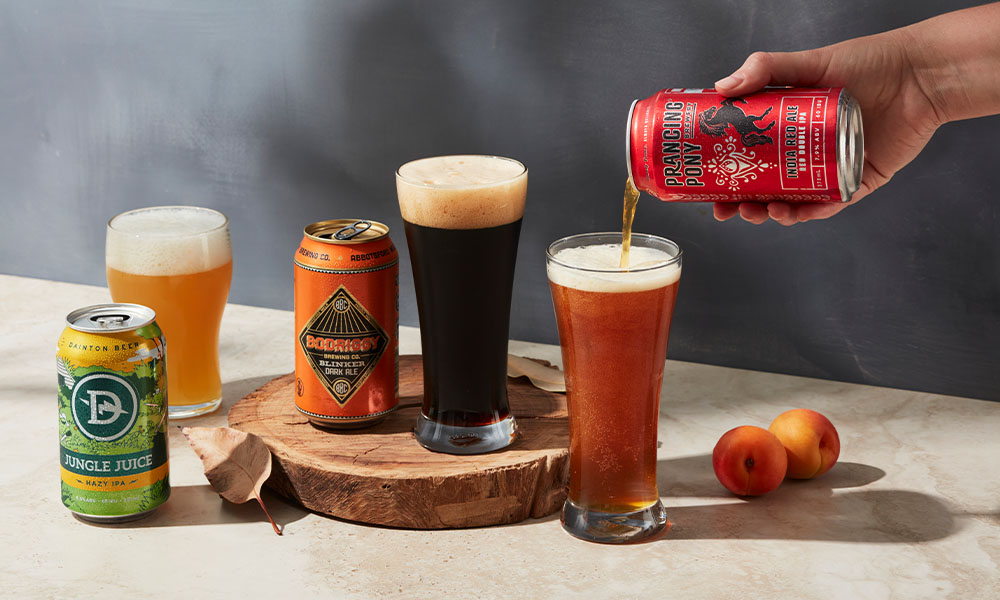- The Brew
The best German beer to celebrate Oktoberfest
Read Time 4 Minutes
Posted 28 Sep 2022
By Vintage Cellars

We’ve put together a list of the best German beers to help you host your own at-home Oktoberfest.
It’s that time of year where beer lovers across the world rejoice – that’s right, it’s Oktoberfest! If you’re unable to hop on a plane to Munich to join in the festivities and raise a stein to all things beer, we’ve got you covered. With our guide to the very best German beer, you can create the fun of a beer tent with your very own at-home Oktoberfest. Simply stock up on the best German beers and follow our tips to creating your own festival at home. Oh, and a pork knuckle in the oven is also compulsory. Prost!
What is Oktoberfest?
Held annually in Munich, Oktoberfest is a festival that attracts millions of people from all over the world. Of course, beer plays centre stage at Oktoberfest with a variety of beer tents pulling many steins for thirsty visitors, but people get dressed up in traditional Bavarian clothing, while also enjoying live music and amusement rides, stalls and games. And don’t forget the traditional foods, too, including giant pork knuckles. “The most exciting part of Oktoberfest is drinking with people from around the world you would never usually meet – it’s a lot of fun!” says Max Hämmerle, a Bavarian native and now head brewer at Sydney’s Philter Brewing. If you’re wondering when Oktoberfest is, it runs from mid- or late-September to around the first Sunday of October.

What are the different types of German beer?
Germans love beer with a capital L. And they produce a lot of it with many varieties. The six most popular varieties of German beer are:
Pilsner. Bottom-fermented and light in colour, a pilsener has a distinct bitter taste with a hoppy aroma. And, of course, you’ll want to serve this correctly in a long neck pilsener class. “I really love drinking pilsners and they’re extremely popular up north [in Germany]. They’re usually quite thin with a lot of IBU [International Bitterness Units] which makes them quite bitter,” Hämmerle says.
Try this: Weihenstephan Pilsner Bottle.
Lager. Much like a bottom-fermented Helles, the popular Lagers have stronger malt flavours and a touch more alcohol content (usually 5%+). “Lagers are a lot like pilsners, but with a top-fermenting yeast so it has a bit of a bananary-thicker flavour,” Hämmerle explains.
Try these: Henninger Lager Bottle, Henninger Premium Lager Bottle (Selected stores only), Weihenstephan Original Bottle, Paulaner Munchner Hell Can.
Dunkles or Helles beer. More pronounced malt and bitter notes, and often darker in colour due to the length of time the malt was roasted, these are often lower in alcohol, making them a popular choice. “These are a malty and balanced, ripe beer, not too thin – and it has a little hop flower on it, which I like,” Hämmerle shares.
Try this: Weihenstephan Dunkel Bottle
Kölsch. Top-fermented and made from a light malt, Kölsch beers have a balanced flavour and smooth finish. They’re usually served in a narrow glass.
Try these: Schofferhofer Hefe Can (Selected stores only), Weihenstephan Hefe Bottle, Weihenstephan Kristall Bottle.
Weiss bier. If you’re looking for a fresh and zesty beer, then this is the one for you. Made from a malt that’s part barley and part wheat, pouring a Weiss bier into the tall, slender glasses is tricky business: first, the glass is dipped in water and then you tilt the glass as much as possible as you slowly pour the beer in. Be warned: if you pour too quickly, you’ll get a load of foam in your glass!
Try these: Hofbrau Weiss Bier Bottle, Paulaner Weissbier Can
Bockbier. Also known as “starkbier” which translated means “strong beer”, this is exactly what it says it is: strong. Full-bodied and packing a punch – alcohol levels are usually 7%+ – this is traditionally brewed in March for drinkers to enjoy during Lent. Colour-wise, Bockbier ranges from golden to very dark. “Bockbier is my favourite type of beer,” Hämmerle says. “It’s not just about the alcohol level, I like the sweetness and maltiness and the combination of the hops being balanced; it’s intense and has a big feel in the mouth.”
What are the rules around making German beers?
Germans take the art of beer making very seriously. So much so, Europe’s first purity law was passed in 1516 (and it’s still in force today!) that says only barley, malt, hops and water are allowed to be used when making beer. “The beer making process in Germany is very precise and we don’t rush it, we make sure we give the beer time to be truly unique,” Hämmerle says. “Also, the purity laws still remain to this day and it’s a sign of the beer’s quality.”
What’s the best Oktoberfest beer?
What is the best Oktoberfest beer? Many will say it’s the one that’s in your hand! Each year at German Oktoberfest, a Marzen – also known as an Oktoberfestbier – is specially produced to commemorate Oktoberfest. It’s similar to a Helles beer with a very quaffable 4.8%-5.6% alcohol content with soft malty notes that makes it extremely pleasant to drink. You’ll find this flying out the beer halls in Munich. “The Fest Bier is a little bit meltier and has less hops in the carbonation, so it’s less fizzy,” Hämmerle says.
Try this: Hofbrau Original Bottle.
- The Brew
- View More Posts The Brew















